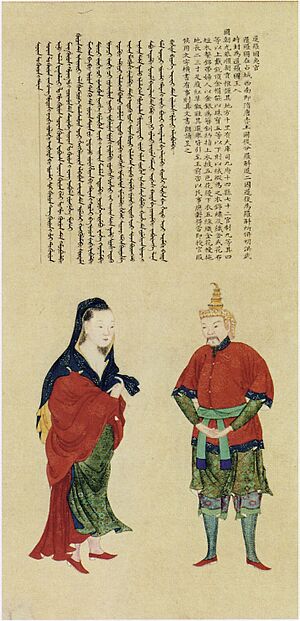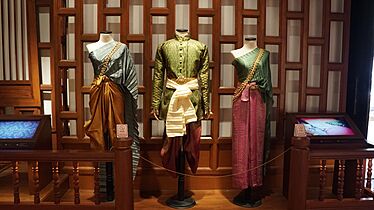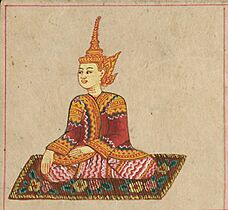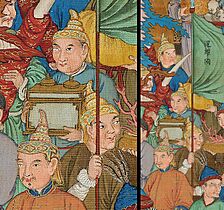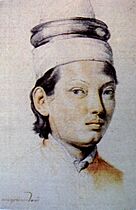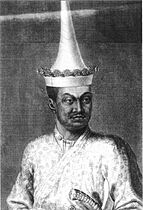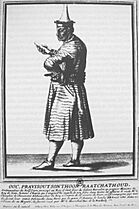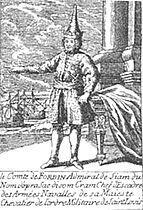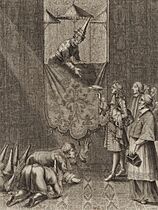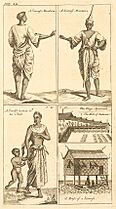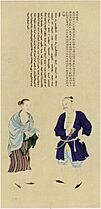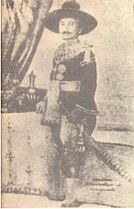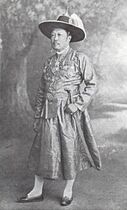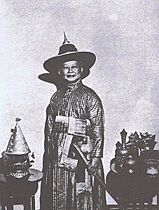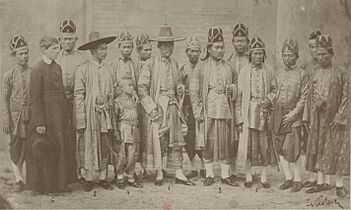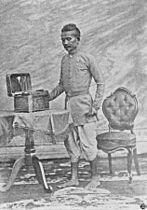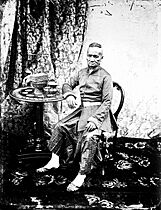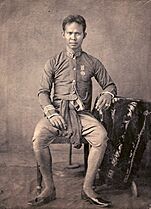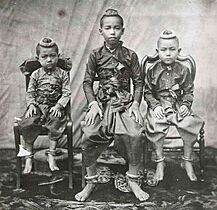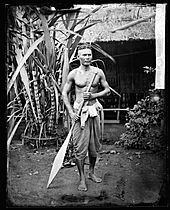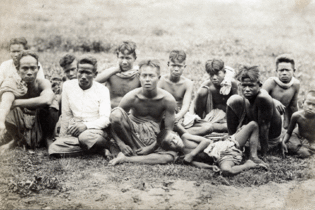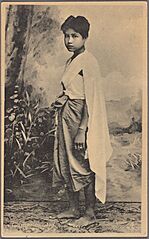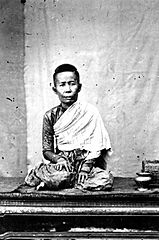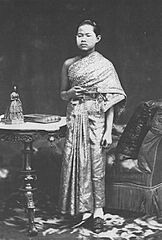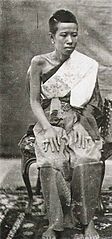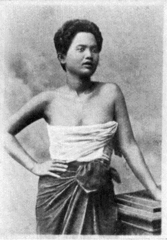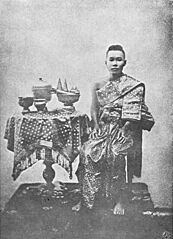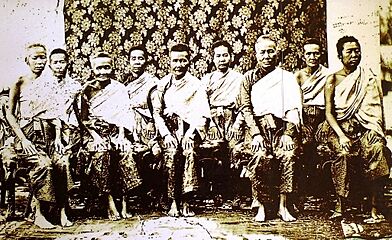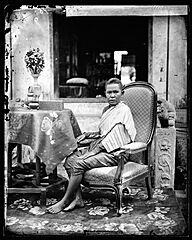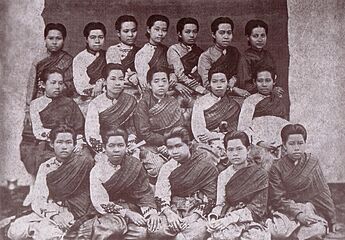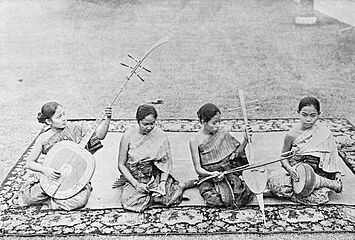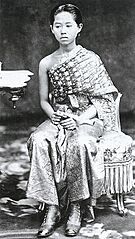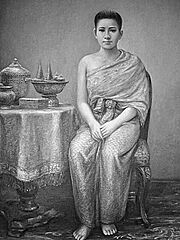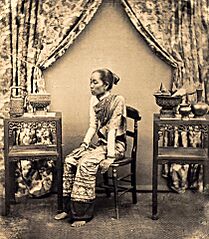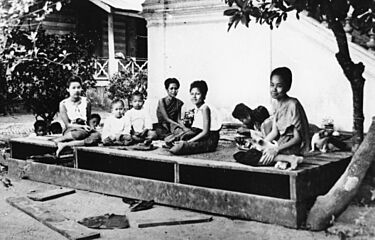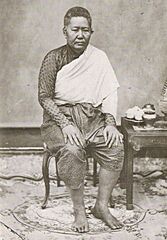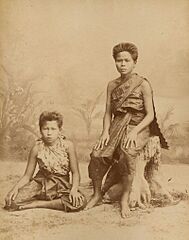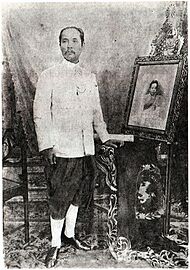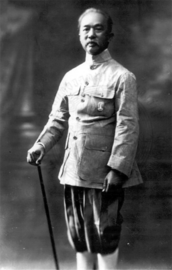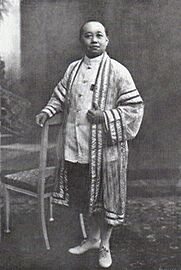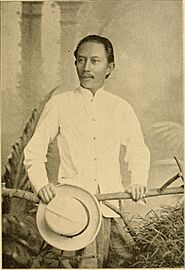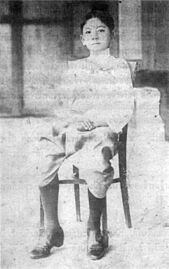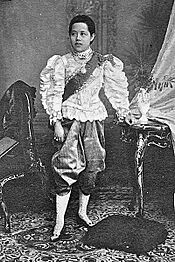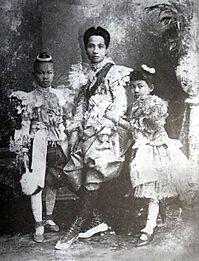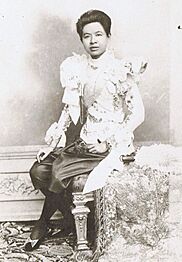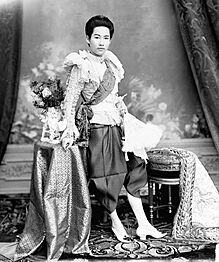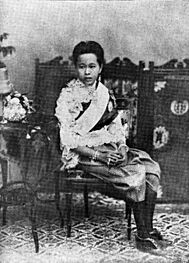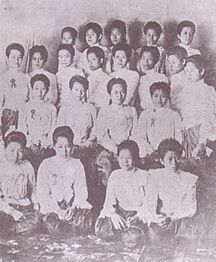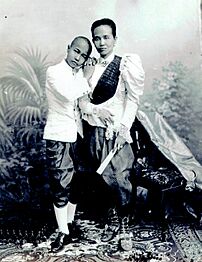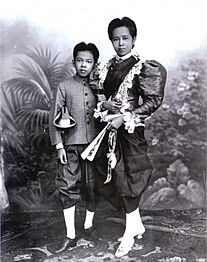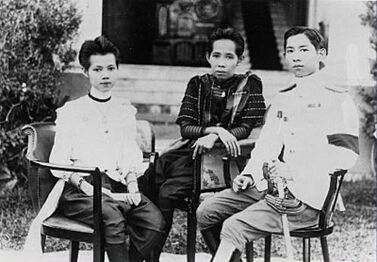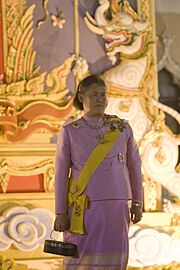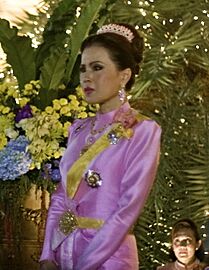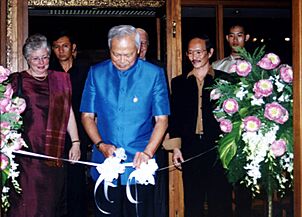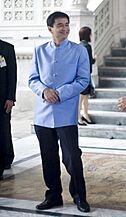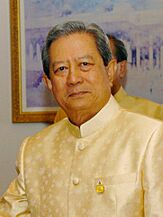History of Thai clothing facts for kids
Thai traditional costumes are special clothes from Thailand's past. They changed a lot over time, depending on the city and the kings who ruled. These clothes can be grouped into six different periods, starting from the 13th century. Long ago, people wore these traditional outfits every day. But now, they are mostly worn for important events like traditional Thai weddings.
Contents
Sukhothai Clothing (13th-15th Century)
The Sukhothai clothing style was popular from the 13th to the 15th century. During this time, the city of Sukhothai brought other Thai cities together to form one kingdom.
Men in Sukhothai wore simple tops with long sleeves and a V-shaped neck. They also had a cloth piece over their shoulders. Their lower body was covered with a loincloth made of silk, held in place by a large metal or gold belt.
Women wore long silk sarongs, which are like wrap-around skirts, often with painted flowers. Their tops usually had full silk sleeves. Married women would also wrap another piece of silk or fabric around their chests.
Ayutthaya Clothing (14th-18th Century)
Ayutthaya clothing was the style from the 14th to the 18th centuries. The city of Ayutthaya was the capital of Thailand for 417 years. This was the longest time Thailand was ruled by one king. Many clothing styles came from the Ayutthaya period. Fashion changed often because of influences from other countries that traded with the kingdom.
Historically, both Thai men and women wore a wrap-around cloth called a chong kraben. Men wore their chong kraben from their waist to about halfway down their thighs. Women wore theirs from their waist to well below their knees. It was normal for people to have bare chests and bare feet. This can be seen in old paintings, books, and photos from before the mid-1800s.
In the royal court, kings and noblemen wore special items. They wore a lomphok, which is a tall, pointed hat made of white cloth wrapped around a bamboo frame. They also wore a Khrui, which is a light outer robe for ceremonies. Traditional Thai clothing changed a lot during the later Rattanakosin period.
-
Thai delegates in Peking in 1761.
-
Claude de Forbin wearing Ayutthayan mandarin dress.
-
The French ambassador meets King Narai in 1685.
Rattanakosin Clothing
Early Rattanakosin Styles
During the early Rattanakosin period, people in central Thailand dressed much like they did in Ayutthaya. However, after the Second Fall of Ayutthaya and repeated attacks from Burma, central Thai women started cutting their hair very short, in a crew-cut style. This short hairstyle was popular until the 1900s.
Before the 20th century, the main way to tell someone's social class by their clothes was by the type of fabric. Richer people used silk with fancy patterns. But both common people and royals wore wrapped clothes, not stitched ones.
- Men's clothing
-
Young Prince Chulalongkorn and his brothers in 1851.
- Women's clothing
-
Tieng Rojanadis, a consort of King Mongkut.
-
Daughters of King Rama II and King Rama III.
-
Daughters of King Mongkut (Rama IV) in early Rattanakosin style clothing.
Modern Rattanakosin Styles
From the 1860s, Thai royals started to adopt Victorian styles. They used these new looks to appear modern both in Thailand and to other countries. Stitched clothing, including court outfits and uniforms, were created during the reign of King Chulalongkorn. Western clothing became popular among city people in Bangkok during this time.
In the early 1900s, King Vajiravudh encouraged Thai women to grow their hair long instead of keeping it short. He also wanted them to wear pha sinh (ผ้าซิ่น), which is a tubular skirt, instead of the chong kraben (โจงกระเบน) wrap.
- Noblemen's clothing
-
King Chulalongkorn wearing the raj pattern costume.
-
Prince Damrong Rajanubhab wearing the raj pattern costume, 1900.
-
King Vajiravudh wearing the raj pattern with a khrui robe.
- Noblewomen's clothing
-
Queen Saovabha Phongsri in 1897.
-
Daughters of King Rama V, 1904.
-
Prince Mahidol Adulyadej with his sister and mother, Queen Sri Savarindira, 1925.
Fascist Thailand (1940s)
On January 15, 1941, Prime Minister Plaek Pibulsonggram issued a new rule. This rule was part of a plan to make Thai dress more modern and Western. It stated that old customs like not wearing shirts or wearing only a wrap-around cloth were not proper public clothing anymore.
Contemporary Thai Clothing
The formal Thai costume is called ชุดไทยพระราชนิยม (chut thai phra ratcha niyom). This means "Thai dress of royal endorsement." It includes several different outfits. These were created in the second half of the 20th century to be the official Thai national costume for formal events.
- Women's clothing
- Men's clothing
-
Prem Tinsulanonda, a former Thai Prime Minister, wearing the "chut thai phra ratcha niyom".
-
Former Thai Prime Minister Abhisit Vejjajiva wearing the "chut thai phra ratcha niyom".
See also
- Traditional Thai clothing


